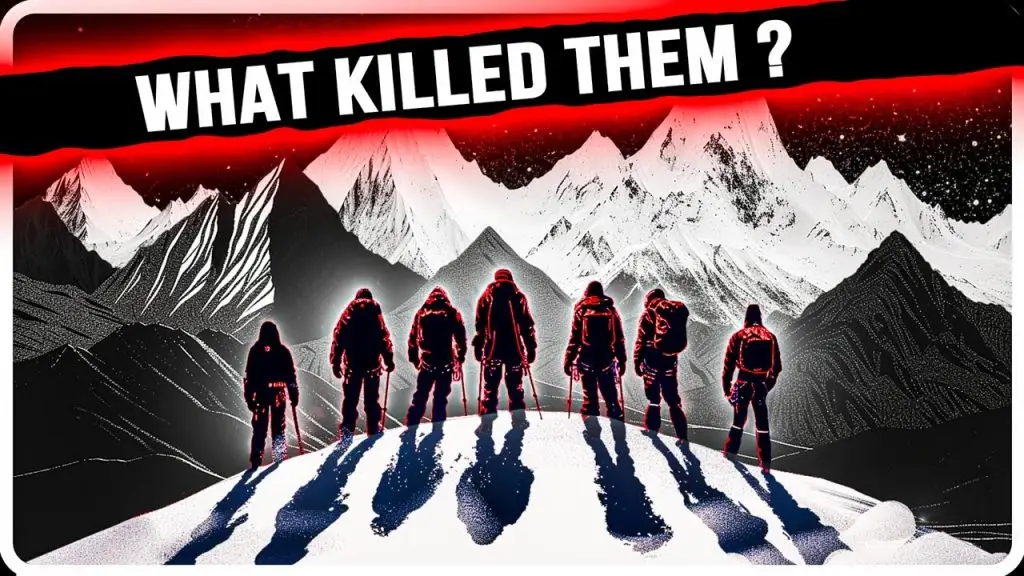The Dyatlov Pass Incident. In 1959, a group of nine hikers led by Igor Dyatlov set out on an adventure in the icy Ural Mountains. Their journey turned into one of the spookiest unsolved mysteries of the modern era. The bizarre circumstances have puzzled people for decades, with theories ranging from avalanches to UFOs, and even the fanciful yeti. These nine hikers were found dead with puzzling injuries and their campsite abandoned, leaving experts scratching their heads for decades.

The story starts with these adventurous souls embarking on what was supposed to be an exhilarating trek. Instead, their mysterious disappearance and the eerie discovery of their tent, cut open from the inside, sparked endless speculation.
Imagine coming across footprints leading away from camp in just socks or bare feet—an impossible situation for anyone in the freezing wilderness.
Though recent studies suggest an avalanche as a likely cause, the strange occurrence still raises more questions than it answers. The Dyatlov Pass Incident is not just a tale of adventure gone wrong. It’s a chilling reminder of nature’s unpredictability and its grip on human curiosity and imagination.
The Dyatlov Pass Incident : The Mysterious Event
In 1959, nine hikers set out on an expedition to the remote Dyatlov Pass in Russia’s Ural Mountains. What occurred next has puzzled people for decades. This cryptic event involved puzzling injuries, a missing eye, and eerie discoveries.
Timeline of the Incident
The Dyatlov Pass trek began on January 23, 1959. Led by Igor Dyatlov, the group aimed to conquer the peaks of the Ural Mountains.
On January 31, they reached what they called “Dead Mountain.” On February 1, they made their last camp there. The next day, communication with the hikers ceased. When the group failed to report back, a search party was launched on February 20.
On February 26, rescuers stumbled upon a baffling scene. A tent had been slashed open, not from the outside, but from within. This clue hinted at sudden panic among the campers. Other unexplained elements, like missing clothes, further added to the intrigue.
Discovery of the Campsite
The search party eventually found the campsite with scattered items suggesting a desperate escape. The hikers’ bodies were located at varying distances from the abandoned tent, some wearing only socks or lacking warm clothes. It was alarming, especially considering the sub-zero temperatures.
Even stranger were the injuries discovered: cracked skulls, broken ribs, and one hiker missing an eye. Yet, there were no signs of a struggle or combat. This only deepened the mystery, leaving room for theories ranging from avalanches to UFOs. Each detail complicates the narrative, leading to endless speculation.
Victims and Survivors
The Dyatlov Pass Incident involved nine skilled hikers from the Ural Polytechnic Institute who tragically lost their lives in Russia’s Ural Mountains. Among them were Igor Dyatlov, Zinaida Kolmogorova, and Lyudmila Dubinina, each remembered for their bravery and leadership. Their team mysteriously ended up scattered on the mountainside, sparking numerous theories about what happened.
Igor Alekseyevich Dyatlov
Igor Dyatlov was a 23-year-old engineering student and the leader of the ill-fated expedition. Known for his experience and leadership skills, he was the one who chose the route.
His body was found far from the main campsite. Despite the freezing conditions, he wore only a few layers of clothing. His determined efforts to ensure the safety of his group and his strategic thinking made him a reliable leader. This tragic incident took his life alongside the rest of his team. To this day, the region is named Dyatlov Pass in remembrance of his leadership.
Zinaida Kolmogorova
Zinaida Kolmogorova was a 22-year-old radio engineering student and one of the two women on the hike. With strong hiking skills, she was known for her vibrant spirit and passion for adventure.
Her body was found close to Igor Dyatlov’s, leading many to believe she played a brave role in the group’s final moments. Zinaida suffered minor injuries compared to others but displayed signs of trauma. Her diary entries offer insights into the group’s journey, capturing the respect and admiration she held among her peers.
Lyudmila Dubinina
Lyudmila Dubinina was a 20-year-old engineering student who brought significant experience to the hiking group. Known for her resilience and strong-willed nature, she was a vital part of the team.
Her body was found in a ravine away from the camp, with severe injuries including chest fractures, suggesting she experienced extreme force. The mystery surrounding her injuries has fueled numerous theories. Despite the harsh conditions, Lyudmila’s fortitude and courage continue to inspire.
Investigation and Research

The Dyatlov Pass Incident has puzzled investigators and researchers for decades. Over time, several theories have emerged about what caused the tragedy that befell the group of hikers. Analyzing the initial examination, considering various hypotheses, and reviewing the criminal case provides insight into this enduring mystery.
Initial Examination
When rescuers first reached the site, they were startled by the bizarre scene. The tent was slashed open from the inside, and the campers had fled without proper clothing into freezing temperatures. This raised several questions about why experienced hikers would act so irrationally.
Early reports noted that some victims had severe injuries, and traces of high radiation were found on their clothing. These unusual findings fueled numerous conspiracy theories, including military involvement and extraterrestrial activities.
Despite rigorous investigation at the time, the true cause of these strange elements remained elusive, leaving family members and investigators searching for answers.
Avalanche Hypothesis
Over the years, avalanches became a leading explanation. Some experts suggested a type of avalanche known as a slab avalanche might have occurred.
This theory posits that a block of snow slid and hit the tent, leading hikers to hurriedly escape to safety. Investigators created models using snow and avalanche simulation to test this idea.
The research showed how a slab avalanche could damage the tent without leaving much trace in the mountain’s terrain. Some geotechnical engineers argued that the injuries found on the hikers matched those seen in avalanche victims.
Reopened investigations, like those led by Andrei Kuryakov, supported this theory and found it consistent, though not definitive, offering an explanation for the unusual circumstances around the tragedy.
Criminal Case Review
Ample theories, like those involving criminal acts, added to the story’s intrigue. Initially, the legal investigation aimed to determine if the deaths were criminal.
The case was classified as unsolved, keeping the files open to new evidence. No direct evidence pointed to foul play, yet the unexplained injuries and radioactive clothing prompted many to speculate about possible military tests in the area.
Subsequent reviews of the criminal case considered both rational explanations like avalanches and more mysterious ones like secret weapons experiments.
These reviews helped bring new insights into the incident and renewed interest in the case. Over time, the Dyatlov Pass Incident became emblematic of how little we sometimes know about the forces of nature and human response in extreme conditions.
Theories and Speculations

The Dyatlov Pass Incident involves nine hikers facing mysterious deaths in the Siberian wilderness. It has sparked various theories, ranging from conspiracy ideas to natural events.
Conspiracy Theories
Conspiracy theories suggest secretive Soviet military tests may have contributed to the tragedy. Some believe the hikers stumbled upon a covert operation, leading to their demise. Others think a UFO or “Fireball” observed in the area was responsible.
These theories are fueled by the lack of clear evidence and mysterious signs at the scene, such as missing tongues and bizarre injuries. Despite numerous investigations, the idea that the Soviet Union had something to hide continues to captivate imaginations.
Natural Disasters
Natural disasters could explain the fate of the hikers. For instance, experts have explored the possibility of an avalanche.
This would account for their sudden flight from the tent and the injuries they sustained.
Recent studies support the slab avalanche theory, suggesting a layer of snow collapsing and pushing them into the wilderness.
The unforgiving weather and rough terrain in the Ural Mountains may have overwhelmed the group.
Katabatic Winds Theory
The Katabatic Winds Theory proposes intense, fast-moving winds could have driven them from their shelter.
These cold, powerful gusts are known to cause significant disorientation and panic.
Such winds might have forced the group to leave their tent rapidly, possibly explaining their scattered belongings and incomplete clothing. The dangers of extreme weather in the region, including katabatic gales, highlight the challenges the hikers faced.
Cultural Impact
The Dyatlov Pass Incident is not just a historical mystery but also a cultural phenomenon with memorable moments and emotional intrigue. From horror movies to gripping documentaries, it has sparked curiosity and imagination across generations.
Media Portrayals
In the world of media, the Dyatlov Pass Incident has been the topic of countless documentaries, fiction books, and movies. These portrayals often elaborate on the mystery, blending facts with imagination.
Films like “The Dyatlov Pass Incident” offer chilling narratives, painting eerie scenarios of what might have happened.
The incident has even inspired video games, where players explore snowy terrains to uncover hidden truths.
Such media outlets have tapped into the enigmatic allure, captivating audiences that crave a mix of mystery and thrill. This interest has also drawn attention to Soviet culture and the Ural region’s history, posing questions about hiking safety in treacherous conditions.
Public Fascination
Public fascination continues to grow, fueled by forums and discussions dissecting every clue.
People are eager to uncover the truth behind the tragedy and seek connections to things like government cover-ups or alien interventions.
The mysterious aura around the incident keeps people talking, with new theories emerging regularly.
Memorials have been set up in Sverdlovsk Oblast, honoring the lost hikers from the Ural Polytechnic Institute. This showcases a sense of friendship and respect for the group.
The incident’s deep emotional impact lingers, drawing enthusiasts and families who feel a personal connection to the tragic event, all yearning for answers.
Geographical Context
The rugged and mysterious Northern Urals are home to some of Russia’s most intriguing landscapes. The areas known as Dyatlov Pass, Kholat Syakhl, and Otorten possess a blend of natural beauty and stark wilderness, contributing to their eerie and captivating reputation.
Description of Dyatlov Pass
Dyatlov Pass is set in the Northern Ural Mountains, roughly 350 kilometers north of Yekaterinburg. It’s a place where tall peaks loom and dense forests stretch as far as the eye can see.
This remote spot is named after Igor Dyatlov, the leader of the ill-fated 1959 expedition. It’s known for its harsh weather and haunting landscapes.
Winter snow blankets the pass, creating a white wonderland that can be as dangerous as it is beautiful. Temperatures often plunge to bone-chilling lows, making navigation a formidable task.
Despite this, it’s a beloved challenge for trekkers and has gained infamy due to the mysterious event that unfolded there.
Kholat Syakhl and Otorten
Kholat Syakhl, meaning “Dead Mountain” in the local Mansi language, is one of the two notable peaks near the pass. With its rocky terrain and inaccessible slopes, it paints a daunting picture.
Legends and tales add to its forbidding air, sometimes lending it an aura of mystery. People are drawn to its rugged beauty, but the risk is always present.
Otorten Mountain, located north of Kholat Syakhl, further highlights the area’s wild character. Its name, translated as “Don’t Go There” by the Mansi people, serves as a cautionary note.
The towering height and challenging routes make it a magnet for adventure-seekers, yet it warns travelers of nature’s unpredictability. The mountains’ cryptic names and treacherous conditions only add to their mystique and allure.
Aftermath and Legacy
The Dyatlov Pass Incident has sparked lasting intrigue and debate. Many theories have tried to explain what happened in the Ural Mountains. The site itself holds a special place in both mystery and history.
Continued Interest
Since the tragic event in 1959, the Dyatlov Pass Incident has captured public imagination. People are fascinated by the mysterious circumstances that surrounded the deaths of the nine hikers led by Igor Alekseyevich Dyatlov.
Despite various investigations, explanations range from avalanches to more unusual theories, all contributing to a rich tapestry of speculation.
Books, documentaries, and podcasts continue to explore this unsolved mystery. Online communities are devoted to discussing possible theories and new findings.
The persistent ambiguity keeps researchers and enthusiasts alike engaged. This has made it one of the most enduring stories of the 20th century.
Preservation of the Site
The spot where the incident occurred has become somewhat of a pilgrimage site for the curious. It attracts mystery buffs and travelers interested in the history of the Ural Polytechnical Institute.
Efforts to preserve the site aim to maintain it as a historical landmark.
Visitors often leave tributes in memory of the ill-fated group who set out on what seemed to be a routine expedition. The site serves as a grim reminder of the hikes into unforgiving terrain.
Its preservation ensures that the story and lessons learned are not forgotten.
Steve is the creative force behind Unique Tales, a blog dedicated to sharing captivating stories that explore the human experience in all its complexity. With a passion for writing and a talent for crafting engaging narratives, Steve's blog is a treasure trove of imaginative tales that transport readers to other worlds and challenge them to see things from new perspectives. From epic adventures to intimate character studies, Steve's stories are always thought-provoking and emotionally resonant. With a growing following of readers who appreciate his unique voice and creative vision, Steve is quickly becoming a rising star in the world of online storytelling.






